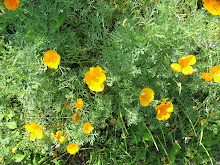I'm often in the garden during off-peak times, when most people are at work. But when I do find others watering, weeding, or just hanging out on one of the stone benches along the main path, not everyone is bipedal or can speak for themselves.
"Can you believe how many babies there are?" my long-time neighborhood friends and I often muse to each other. "Is there something in the water?" Compared to, say, 5-10 years ago, we're seeing many more of them, in strollers, slings, and backpacks, rolling on blankets spread out on the grass, and splashing in one of the wading pools near the shed. Surveying the crowd at a barbecue, I always seem to find a swollen belly or two in my field of vision.
It appears to me that compared to other neighborhoods, Jamaica Plain is experiencing its own baby boom (Not that I've performed any census). More and more triple-deckers have gone condo; there seems to be an increase in couples who are making a financial commitment to the neighborhood, and chances are, they are making other commitments as well.
To all of those busy parents of newborns and toddlers who manage to squeeze a little gardening time into their busy schedules: keep it up! As little ones develop, tending a plot is a wonderful way to help them develop an awareness of nature. There are many
plants that they can grow, or help water or harvest. They can learn to
identify the different species of butterflies or other garden creatures. It can be a little nerve-wracking when they help themselves to a neighbor's strawberries, get stung by nettles, or confuse a basil seedling with a weed, but gardening can help children in making many
connections that can enhance their education and development, and lead to a
healthier diet.
I remember how productive I was when my daughter could sleep in her stroller, shaded by a blanket. Then the napping ceased and mobility increased, and there was the season that my plot was so neglected that, had this occurred after the community garden became official, it would have been reassigned. Luckily that era was short lived, as my daughter developed a love for carrots and snapdragons, among the first plants we tended in our new plot when the community garden was redesigned, around 2004 if I remember correctly.
Now she's 7, and a little more ambivalent when it comes to helping out. She's more likely to help harvest or turn on the hose only if I ask her, and if she's reached a point in the book she's reading where she can put it down (I guess I shouldn't really complain if one healthy activity replaces another).
I wonder if having more kids her age around in the garden would revitalize her interest. But that's an issue to ponder for another time. (It's time to relinquish the non-wireless cable connection in our vacation house to another user.)






